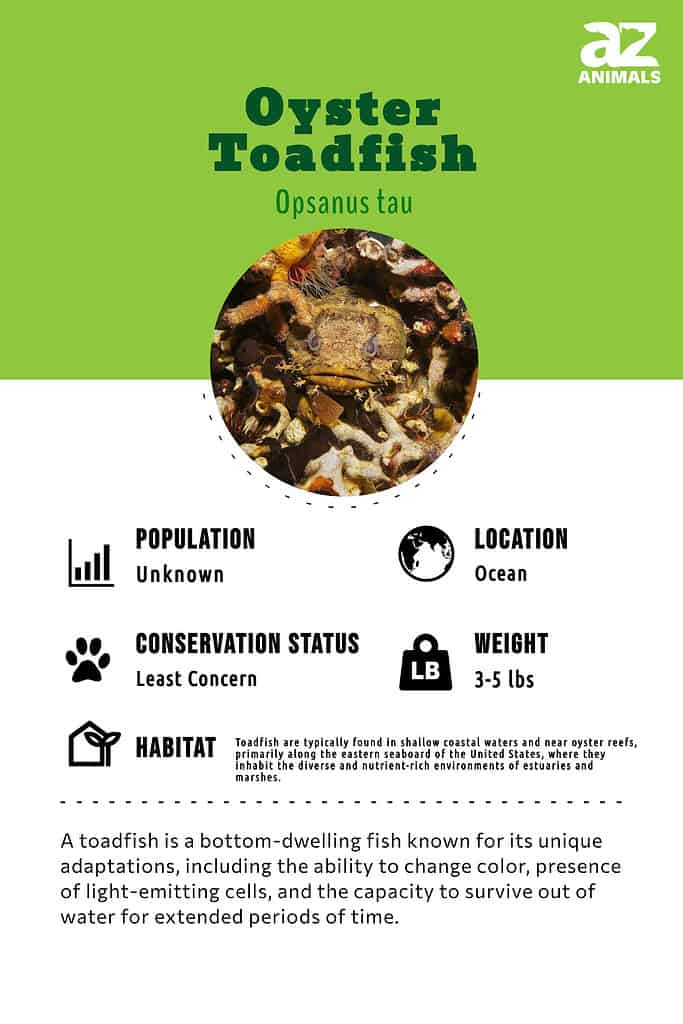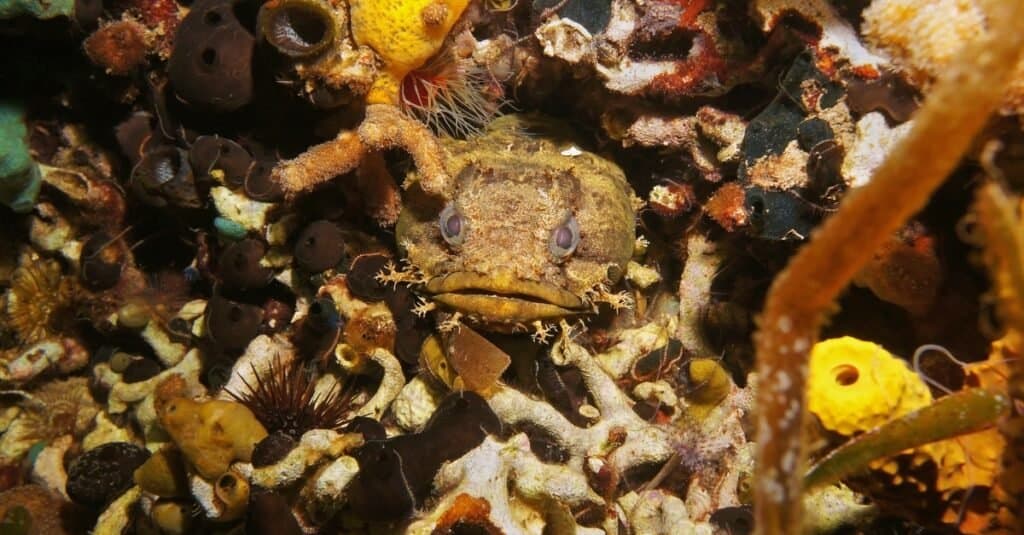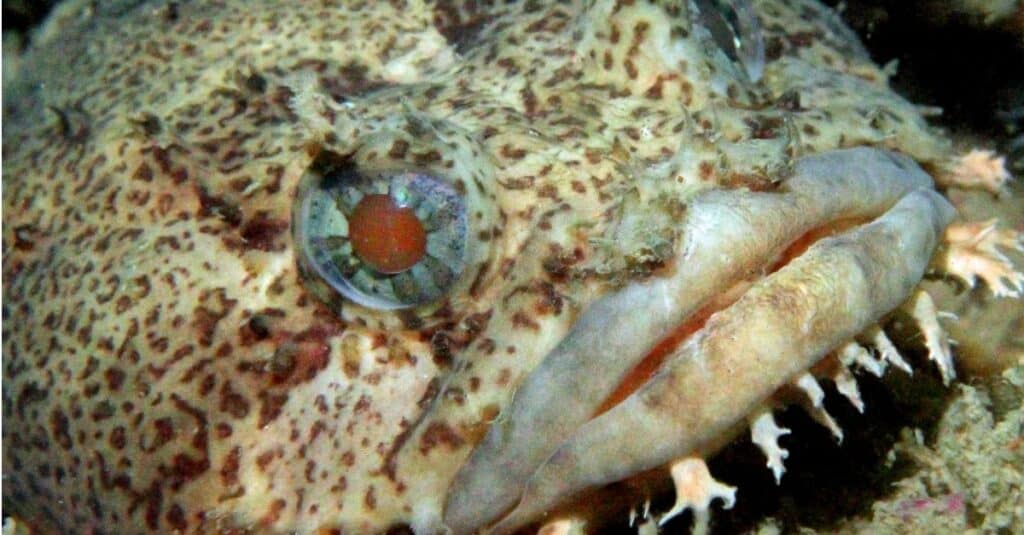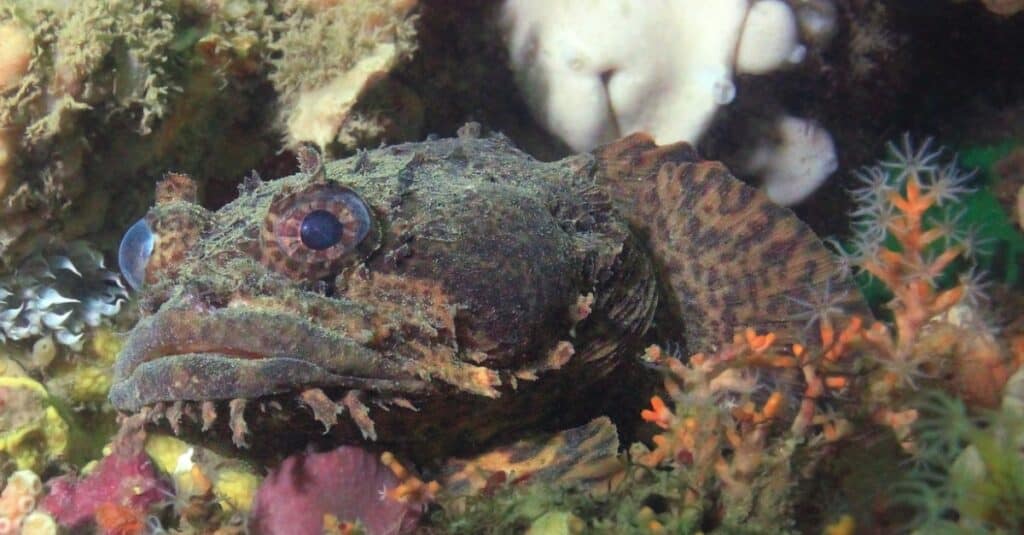Oyster Toadfish
Opsanus tau
The oyster toadfish can produce poison to protect itself
Advertisement
Oyster Toadfish Scientific Classification
- Kingdom
- Animalia
- Phylum
- Chordata
- Class
- Actinopterygii
- Order
- Batrachoidiformes
- Family
- Batrachoididae
- Genus
- Opsanus
- Scientific Name
- Opsanus tau
Read our Complete Guide to Classification of Animals.
Oyster Toadfish Conservation Status
Oyster Toadfish Facts
- Prey
- Mollusks, crustaceans, squids, worms, and fish
- Group Behavior
- Solitary
- Fun Fact
- The oyster toadfish can produce poison to protect itself
- Biggest Threat
- predators
- Most Distinctive Feature
- The long mouth and big, bulging eyes
- Other Name(s)
- Dowdies, oyster crackers, and oyster catchers
- Gestation Period
- a month
- Optimum pH Level
- 6.6-7.2 pH
- Predators
- Sharks and large fish
- Diet
- Omnivore
- Type
- Ray-finned fish
- Common Name
- Oyster Toadfish
- Number Of Species
- -1
View all of the Oyster Toadfish images!

“The oyster toadfish is also known as the ugly toad.”
The oyster toadfish is a strange-looking (some may even say ugly) fish that makes its home in the secluded holes and hiding spots along the shore of the eastern United States. The bumpy skin, long mouth, and bulging eyes have earned it very appropriate comparisons to the common toad.
The sight of this fish may be a little startling, but there’s little to be worried about. As long as you don’t try to handle one, they are fairly harmless creatures. While not a popular game fish, they’re also highly edible to eat.
3 Incredible Oyster Toadfish Facts!

The oyster toadfish has the remarkable ability to endure extended periods of time outside of water and still maintain its survival.
©Damsea/Shutterstock.com
- One of the most interesting facts is that the oyster toadfish has large poisonous spines located around the gill covers. The pain is comparable to a bee sting.
- The oyster toadfish can survive out of water for long periods of time.
- This species is surprisingly vocal, especially during the mating season. When it’s handled out of the water, it makes a grunting noise.
Evolution and Origins
Toadfish, belonging to the family Batrachoididae and the order Batrachoidiformes, encompasses approximately 80 species of benthic fish. These predominantly New World inhabitants are primarily found in warm seas, with occasional occurrences in freshwater habitats.
Toadfish possess an additional intriguing adaptation in the form of numerous light-emitting cells known as photophores, which are distributed across their body.
These specialized glands can reach up to 700 in number and are believed to house luminescent bacteria, although their exact function remains partially elusive.
Classification and Scientific Name

Opsanus tau is the scientific denomination assigned to the oyster toadfish species.
©iStock.com/Swimwitdafishes
The scientific name of the oyster toadfish is Opsanus tau. It’s not entirely clear how this species earned its name, but tau is the 19th letter in the Greek alphabet, corresponding to “T.” There are currently six living species of toadfish in the genus Opsanus. Together they belong to the wider toadfish family.
Appearance

These fish have the ability to alter their coloration, enabling them to camouflage themselves by matching the appearance of the ocean floor.
©iStock.com/Swimwitdafishes
The oyster toadfish has an unusual scale-less body, measuring about a foot long, with a large, elongated head, bulging eyes, rounded teeth, a very long mouth, flaps of skin around the lips, and whiskers on the cheeks and jaw. Instead of scales, the oyster toadfish is covered in thick mucous and even the occasional wart. It is also characterized by yellow or olive-brown spots and bars with a pale belly. These fish are capable of changing their colors to match the ocean bottom to help them blend in.
Distribution, Population, and Habitat

The oyster toadfish can be found in shallow water environments and oyster reefs along the entire eastern coastline of the United States, spanning a continuous stretch from Maine to Florida.
©iStock.com/Swimwitdafishes
The oyster toadfish lives in shallow water habitats and oyster reefs all along the eastern seaboard of the United States; their large range encompasses an unbroken stretch between Maine and Florida. They will find almost anything to hide in: reefs, rocks, caves, wrecks, vegetation, and even discarded tires and trash.
While population estimates are unknown, it is currently classified as a species of least concern by the IUCN Red List. There are currently no significant threats to this species apart from predators. These tough and hardly fish are often able to thrive in poor environmental conditions.
Predators and Prey
The oyster toadfish is mostly a carnivore; almost all its food comes from animal sources.
What eats the oyster toadfish?
The oyster toadfish is preyed upon by sharks and large fish. Rocky outcrops and debris provide a source of cover for them to hide in. As a last resort, they may unleash the poisonous spines on their harasser. Unfortunately, predators are a constant threat to this fish, especially as a baby.
What does the oyster toadfish eat?
The oyster toadfish consumes various kinds of worms, crabs, shrimp, squids, fish, oysters, and other mollusks. It is a capable ambush predator, lying in wait for food to pass by. The brown-colored bodies help camouflage them against the ocean bottom. Once they’ve caught their prey, their powerful jaws and teeth enable them to crack open any hard shells or thick skin. Because they need little food to survive, they can afford to wait in between meals.
Reproduction and Lifespan
There are still many facts about their reproduction we do not know, but toadfish spawning normally occurs between the months of April and October. The male creates a nest in an isolated location, such as rock crevices, submerged wood, or random debris, and then calls for the female to approach with an immense fog-horn sound that travels incredible distances.
The female will deposit a clutch of sticky eggs on top of the nest and then depart immediately. After fertilizing them, the male will keep watch over the eggs until they are ready to hatch about a month later. A fussy and exacting parent, he keeps the nest clean and uses his fins to fan the eggs. Upon hatching, the young baby fish remain attached to the nest by the yolk. It will take them a few days to consume what remains of the egg.
Even after they learn how to swim, the male will continue to protect them for the next few weeks, but they are free to come and go as they please.
At this point, once the father’s involvement ends, the baby fish must learn how to fend for themselves. A lot of them will fall prey to predators in the early part of the life cycle, and only some of the initial clutch will survive until adulthood. The oyster toadfish is thought to have a maximum lifespan of around 24 years.
Fishing and Cooking
The oyster toadfish has a reputation among fishers as a small nuisance; they steal bait intended for other fish, and if caught, they will start to snap very aggressively with their blunt teeth. Because of their venomous spines, their powerful bite, and their very grizzly appearance, they are not a popular dish.
They are usually discarded back into the sea. But they are actually just as edible as any other tasty marine fish, and some fishers are adamant that they make an excellent catch. Live bait, including worms and shrimp, are thought to work best. Its firm white meat is often filleted, but it can be prepared in any conceivable manner. The venomous spines definitely need to be removed though.
View all 66 animals that start with OOyster Toadfish FAQs (Frequently Asked Questions)
Where are oyster toadfish found?
They have a large range along the eastern coast of the United States.
Are oyster toadfish good for eating?
Yes, this species is highly edible and healthy to eat. Although they’re rarely caught on an industrial scale, many people catch them recreationally with live bait.
Are oyster toadfish poisonous?
Yes, the venom is about as painful as a bee sting.
How do male oyster toadfish attract females?
They attract mates with a unique foghorn-like sound.
Do oyster toadfish have scales?
No, their bodies do not contain any scales.
Can oyster toadfish live in freshwater?
The oyster toadfish live in saltwater only.
Why do oyster toadfish live in oyster reefs?
They live almost anywhere along the shore, including oyster reefs, with enough small and secluded spots to hide from predators.
When do oyster toadfish breed?
The oystery toadfish breed every year between April and October.
How long do oyster toadfish live?
The oyster toadfish can live up to 24 years in the wild.
How big do oyster toadfish get?
This species generally grows around a foot long, but the maximum size is perhaps around 17 inches long.
Thank you for reading! Have some feedback for us? Contact the AZ Animals editorial team.
Sources
- Chesapeake Bay Program / Accessed October 30, 2021
- / Accessed October 30, 2021


















